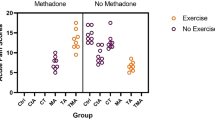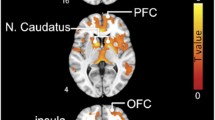Abstract
Rationale
Exercise stimulates the release of endogenous opioid peptides and increases nociceptive (i.e. pain) thresholds in both human and animal subjects. During chronic, long-term exercise, sensitivity to the effects of morphine and other µ opioids decreases, leading some investigators to propose that exercise may lead to the development of cross tolerance to exogenously administered opioid agonists.
Objective
The purpose of the present investigation was to examine the effects of chronic exercise on sensitivity to µ opioids, and to determine whether these effects can be attributed to the development of opioid tolerance and dependence.
Methods
Rats were obtained at weaning and housed singly in standard polycarbonate cages (sedentary) or modified cages equipped with exercise wheels (exercise). After 6 weeks under these conditions, opioids possessing a range of relative efficacy at the µ receptor (morphine, levorphanol, buprenorphine, butorphanol, nalbuphine) were examined in a warm-water tail-withdrawal procedure.
Results
Morphine, levorphanol and buprenorphine produced maximal levels of antinociception in both groups of rats, but all were more potent in sedentary rats than in exercising rats. Butorphanol and nalbuphine produced maximal levels of antinociception in sedentary rats under some conditions in which they failed to produce antinociception in exercising rats. Sensitivity to the effects of buprenorphine was decreased in sedentary rats that were transferred to cages equipped with exercise wheels, and increased in exercising rats that were transferred to sedentary housing conditions. In the latter group, exercise output prior to housing reassignment was positively correlated with increases in sensitivity to buprenorphine following housing reassignment. Naloxone administration precipitated a mild withdrawal syndrome in exercising rats that was not readily apparent in sedentary rats.
Conclusions
These data suggest that chronic exercise leads to the development of µ-opioid tolerance and physical dependence, and that these effects are similar to those produced by chronic opioid administration.






Similar content being viewed by others
References
Adams JU, Paronis CA, Holtzman SG (1990) Assessment of relative intrinsic activity of mu-opioid analgesics in vivo by using beta-funaltrexamine. J Pharmacol Exp Ther 255:1027–1032
Barrett AC, Cook CD, Terner JM, Craft RM, Picker MJ (2001) Importance of sex and relative efficacy at the mu opioid receptor in the development of tolerance and cross-tolerance to the antinociceptive effects of opioids. Psychopharmacology 158:154–164
Baumhaker Y, Ben-Dor T, Bar-Hamburger R, Sarne Y (1994) Characterization of a triple opioid system in the human neuroblastoma NMB cell line. Brain Res 665:94–100
Belcheva MM, Barg J, McHale RJ, Dawn S, Ho MT, Ignatova E, Coscia CJ (1993) Differential down- and up-regulation of rat brain opioid receptor types and subtypes by buprenorphine. Mol Pharmacol 44:173–179
Brady LS, Herkenham M, Long JB, Rothman RB (1989) Chronic morphine increases mu-opiate receptor binding in rat brain: a quantitative autoradiographic study. Brain Res 477:382–386
Butelman ER, Winger G, Zernig G, Woods JH (1995) Butorphanol: characterization of agonist and antagonist effects in rhesus monkeys. J Pharmacol Exp Ther 272:845–843
Carmody J, Cooper K (1987) Swim stress reduces chronic pain in mice through an opioid mechanism. Neurosci Lett 74:358–363
Chen JJ, Dymshitz J, Vasko MR (1997) Regulation of opioid receptors in rat sensory neurons in culture. Mol Pharmacol 51:666–673
D'Anci KE, Gerstein AV, Kanarek RB (2000) Long-term voluntary access to running wheels decreases kappa-opioid antinociception. Pharmacol Biochem Behav 66:343–346
Diaz A, Ruiz F, Florez J, Hurle MA, Pazos A (1995) Mu-opioid receptor regulation during opioid tolerance and supersensitivity in rat central nervous system. J Pharmacol Exp Ther 274:1545–1551
Droste C, Meyer-Blankenburg H, Greenlee MW, Roskamm H (1988) Effect of physical exercise on pain thresholds and plasma beta-endorphins in patients with silent and symptomatic myocardial ischaemia. Eur Heart J 9 (Suppl N):25–33
Droste C, Greenlee MW, Schreck M, Roskamm H (1991) Experimental pain thresholds and plasma beta-endorphin levels during exercise. Med Sci Sports Exerc 23:334–342
Emmerson PJ, Clark MJ, Mansour A, Akil H, Woods JH, Medzihradsky F (1996) Characterization of opioid agonist efficacy in a C6 glioma cell line expressing the mu opioid receptor. J Pharmacol Exp Ther 278:1121–1127
Funada M, Schutz CG, Shippenberg TS (1996) Role of delta-opioid receptors in mediating the aversive stimulus effects of morphine withdrawal in the rat. Eur J Pharmacol 300:17–24
Garzon J, Rodriguez-Diaz M, Lopez-Fando A, Garcia-Espana A, Sanchez-Blazquez P (2002) Glycosylated phosducin-like protein long regulates opioid receptor function in mouse brain. Neuropharmacology 42:813–828
Gellert VF, Holtzman SG (1978) Development and maintenance of morphine tolerance and dependence in the rat by scheduled access to morphine drinking solutions. J Pharmacol Exp Ther 205:536–546
Goldfarb AH, Hatfield BD, Armstrong D, Potts J (1990) Plasma beta-endorphin concentration: response to intensity and duration of exercise. Med Sci Sports Exerc 22:241–244
Golland LC, Evans DL, Stone GM, Tyler-McGowan CM, Hodgson DR, Rose RJ (1999) Maximal exercise transiently disrupts hormonal secretory patterns in standard bred geldings. Equine Vet J Suppl 30:581–585
Haier RJ, Quaid K, Mills JC (1981) Naloxone alters pain perception after jogging. Psychiatry Res 5:231–232
Higgins GA, Sellers EM (1994) Antagonist-precipitated opioid withdrawal in rats: evidence for dissociations between physical and motivational signs. Pharmacol Biochem Behav 48:1–8
Hoffmann P, Terenius L, Thoren P (1990) Cerebrospinal fluid immunoreactive beta-endorphin concentration is increased by voluntary exercise in the spontaneously hypertensive rat. Regul Pept 28:233–239
Houghten RA, Pratt SM, Young EA, Brown H, Spann DR (1986) Effect of chronic exercise on beta-endorphin receptor levels in rats. NIDA Res Monogr 75:505–508
Institute of Laboratory Animal Resources (1996) Guide for the care and use of laboratory animals. National Academy Press, Washington, D.C.
Janal MN (1996) Pain sensitivity, exercise and stoicism. J R Soc Med 89:376–81
Janal MN, Colt EW, Clark WC, Glusman M (1984) Pain sensitivity, mood and plasma endocrine levels in man following long-distance running: effects of naloxone. Pain 19:13–25
Kanarek RB, Gerstein AV, Wildman RP, Mathes WF, D'Anci KE (1998) Chronic running-wheel activity decreases sensitivity to morphine-induced analgesia in male and female rats. Pharmacol Biochem Behav 61:19–27
Kenakin TP (1993) Pharmacologic analysis of drug-receptor interaction. Raven Press, New York
Koltyn KF (2000) Analgesia following exercise: a review. Sports Med 29:85–98
Law PY, Bergsbaken C (1995) Properties of delta opioid receptor in neuroblastoma NS20Y: receptor activation and neuroblastoma proliferation. J Pharmacol Exp Ther 272:322–332
Lee PH, McNutt RW, Chang KJ (1993) A nonpeptidic delta opioid receptor agonist, BW373U86, attenuates the development and expression of morphine abstinence precipitated by naloxone in rat. J Pharmacol Exp Ther 267:883–887
Lett BT, Grant VL, Koh MT, Flynn G (2002) Prior experience with wheel running produces cross-tolerance to the rewarding effect of morphine. Pharmacol Biochem Behav 72:101–105
Linseman MA (1977) Naloxone-precipitated withdrawal as a function of the morphine-naloxone interval. Psychopharmacology 54:159
Looy H, Eikelboom R (1989) Wheel running, food intake, and body weight in male rats. Physiol Behav 45:403–405
Malatynska E, Wang Y, Knapp RJ, Waite S, Calderon S, Rice K, Hruby VJ, Yamamura HI, Roeske WR (1996) Human delta opioid receptor: functional studies on stably transfected Chinese hamster ovary cells after acute and chronic treatment with the selective nonpeptidic agonist SNC-80. J Pharmacol Exp Ther 278:1083–1089
Manning BH, Mao J, Frenk H, Price DD, Mayer DJ (1996) Continuous co-administration of dextromethorphan or MK-801 with morphine: attenuation of morphine dependence and naloxone-reversible attenuation of morphine tolerance. Pain 67:79–88
Marek P, Mogil JS, Sternberg WF, Panocka I, Liebeskind JC (1992) N-Methyl-d-aspartic acid (NMDA) receptor antagonist MK-801 blocks non-opioid stress-induced analgesia. II. Comparison across three swim-stress paradigms in selectively bred mice. Brain Res 578:197–203
Mathes WF, Kanarek RB (2001) Wheel running attenuates the antinociceptive properties of morphine and its metabolite, morphine-6-glucuronide, in rats. Physiol Behav 74:245–251
McKearney JW (1985) Tolerance to behavioral effects of clonidine after chronic administration of morphine. Pharmacol Biochem Behav 22:573–576
Mehl ML, Schott HC 2nd, Sarkar DK, Bayly WM (2000) Effects of exercise intensity and duration on plasma beta-endorphin concentrations in horses. Am J Vet Res 61:969–973
Mougin C, Henriet MT, Baulay A, Haton D, Berthelay S, Gaillard RC (1988) Plasma levels of beta-endorphin, prolactin and gonadotropins in male athletes after an international nordic ski race. Eur J Appl Physiol Occup Physiol 57:425–429
O'Connor PJ, Cook DB (1999) Exercise and pain: the neurobiology, measurement, and laboratory study of pain in relation to exercise in humans. Exerc Sport Sci Rev 27:119–166
Paronis CA, Holtzman SG (1992) Development of tolerance to the analgesic activity of mu agonists after continuous infusion of morphine, meperidine or fentanyl in rats. J Pharmacol Exp Ther 262:1–9
Ruffolo RR (1982) Important concepts of receptor theory. J Auton Pharmacol 2:277–295
Ryan ED, Kovacic CR (1966) Pain tolerance and athletic participation. Percept Mot Skills 22:383–390
Scott V, Gijsbers K (1981) Pain perception in competitive simmers. Br Med J 283:91–93
Selley DE, Qixu L, Childers SR (1998) Signal transduction correlates of mu opioid agonist intrinsic efficacy: receptor-stimulated [35S]GTPγS binding in mMOR-CHO cells and rat thalamus. J Pharmacol Exp Ther 285:496–505
Selley DE, Cao C, Qixu L, Childers SR (2000) Effects of sodium on agonist efficacy for G-protein activation in mu-opioid receptor-transfected CHO cells and rat thalamus. Br J Pharmacol 130:987–996
Shyu BC, Andersson SA, Thoren P (1982) Endorphin mediated increase in pain threshold induced by long-lasting exercise in rats. Life Sci 30:833–840
Smith MA, French AM (2002) Age-related differences in sensitivity to the antinociceptive effects of kappa opioids in adult male rats. Psychopharmacology 162:255–264
Smith MA, Gray JD (2001) Age-related differences in sensitivity to the antinociceptive effects of opioids in male rats. Influence of nociceptive intensity and intrinsic efficacy at the mu receptor. Psychopharmacology 156:445–453
Smith MA, Picker MJ (1998) Tolerance and cross-tolerance to the rate-suppressing effects of opioids in butorphanol-treated rats: influence of maintenance dose and relative efficacy at the mu receptor. Psychopharmacology 140:57–68
Smith MA, Barrett AC, Picker MJ (1999) Antinociceptive effects of opioids following acute and chronic administration of butorphanol: influence of stimulus intensity and relative efficacy at the mu receptor. Psychopharmacology 143:261–269
Tallarida RJ, Murray RB (1987) Manual of pharmacologic calculations with computer programs. Springer, Berlin, Heidelberg, New York
Terman GW, Morgan MJ, Liebeskind JC (1986) Opioid and non-opioid stress analgesia from cold water swim: importance of stress severity. Brain Res 372:167–171
Tierney G, Carmody J, Jamieson D (1991) Stress analgesia: the opioid analgesia of long swims suppresses the non-opioid analgesia induced by short swims in mice. Pain 46:89–95
Walker EA, Young AM (2001) Differential tolerance to antinociceptive effects of mu opioids during repeated treatment with etonitazene, morphine, or buprenorphine in rats. Psychopharmacology 154:131–142
Walker EA, Butelman ER, DeCosta BR, Woods JH (1993) Opioid thermal antinociception in rhesus monkeys: receptor mechanisms and temperature dependency. J Pharmacol Exp Ther 271:959–968
Walker EA, Tiano MJ, Benyas SI, Dykstra LA, Picker MJ (1999) Naltrexone and beta-funaltrexamine antagonism of the antinociceptive and response rate-decreasing effects of morphine, dezocine, and d-propoxyphene. Psychopharmacology 144:45–53
Wei ET (1981) Enkephalin analogs and physical dependence. J Pharmacol Exp Ther 216:12–18
Yoburn BC, Billings B, Duttaroy A (1993) Opioid receptor regulation in mice. J Pharmacol Exp Ther 265:314–320
Young AM, Masaki MA, Geula C (1992) Discriminative stimulus effects of morphine: effects of training dose on agonist and antagonist effects of mu opioids. J Pharmacol Exp Ther 261:246–257
Zimmerman DM, Leander JD, Reel JK, Hynes MD (1987) Use of beta-funaltrexamine to determine mu opioid receptor involvement in the analgesic activity of various opioid ligands. J Pharmacol Exp Ther 241:374–378
Acknowledgements
This study was supported by Davidson College and US Public Service Grants DA13461 and DA14255 from the National Institute on Drug Abuse. The authors wish to thank Amy Becton for expert technical assistance and Drs. Drake Morgan and Mitchell Picker for helpful comments made on an earlier version of this manuscript. Portions of these data were presented at the 2000 annual meeting of the Society for Neuroscience in San Diego, Calif., USA.
Author information
Authors and Affiliations
Corresponding author
Rights and permissions
About this article
Cite this article
Smith, M.A., Yancey, D.L. Sensitivity to the effects of opioids in rats with free access to exercise wheels: µ-opioid tolerance and physical dependence. Psychopharmacology 168, 426–434 (2003). https://doi.org/10.1007/s00213-003-1471-5
Received:
Accepted:
Published:
Issue Date:
DOI: https://doi.org/10.1007/s00213-003-1471-5




